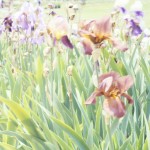IN THE GARDEN
Five minutes passed as I stood in place taking stock of my precious garden. I stared in silence at the hopelessly tangled mass of dried mint stems matted together in a broad cover over all three tiers of dried, hard lifeless dirt. Crisp brown mint leaves clung onto tough wiry stems which refused to break as I pulled at them with my shoes.
I wasn’t surprised. During the past three years problems had overtaken my life. With the gardener out of sight, mint tendrils had crawled out of their boundaries, weaving over and under flowers and vegetables. Their takeover was finally halted when our automatic sprinklers quit and the Arizona sun finally burned the plants dead.
I pushed gravel off the stepping stones with my toes and began walking down the slate pathway to survey the full damage. On my right, the long board I used to kneel on between two garden sections had rotted into a crumbly length of bone white skeleton. Standing straight up out of the mess of mint, brittle leafless stems gave evidence of where tomato and pepper plants had died. On the upper garden bed, individual clumps of gray twigs marked a row of once beautiful pink carnation plants.
And as a final effect, like a military camouflage net, dried eucalyptus leaves and twigs had blown out of a neighbor’s tree and now covered everything.
I felt at home in this neglected garden of death. I understood its pain. It was a visual illustration of my own hurts. We were wedded in a struggle of life and death, my garden and me.
Reaching the top of the pathway, I turned around to look back over the landscape. Life looked very brown and dry. But if you knew where to look, there were signs of green.
I remembered my mother telling me, “You can’t kill mint.” She was right. Mint roots burrow deeply into the soil. I knew their long white threads only needed for me to repair the sprinkler system.
Birds were busy rustling under the eucalyptus leaves and scratching in the dried beds. They knew what I knew. Swiss chard and cilantro seeds were plentiful. Like the mint, they only needed water in order to sprout and grow.
Each clump of dead carnation plant at my feet was decorated with round tufts of dried carnations packed with seeds. I bent down and pinched these off, pressing them into the soil.
The dead stems and leaves might look useless to some, but I knew they would give life to the hard soil. I made plans to dig them into the garden where, mixed with water, they could decay into valuable mulch, making the soil dark and rich again.
Closing my eyes, I raised my heart to God. I gave thanks for the seeds of hope that were close at hand for my garden. And I gave thanks for the garden that would plant new hope in my heart, renewing life together under God’s love and protection, my garden and me.
TABLE OF CONTENTS
******************************
Copyright 2013. All Rights Reserved.

